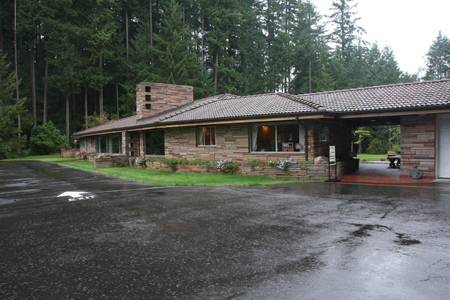
There are many people I know that have avoided Earth Science classes, equating it with a class in trigonometry.
I have to be honest and say that when tasked with writing about the Rice Northwest Museum of Rocks & Minerals, I was less than enthused. After all, I get to travel around the state and see any number of exciting attractions, rocks and minerals seems like a step down from carousels, Sea Lion Caves and historic theaters.
What I found is that a visit to the Rice NW Museum of Rocks & Minerals was a fun adventure, where I spent more time that I planned for because it was so interesting. Where else can you actually touch a meteor?
The museum is spread across two buildings and a gift shop, with the main building being the former home of Helen and Richard Rice, avid rock and mineral collectors who started their collection in 1938.
They are founders of the museum, who donated the buildings and wooded acreage to the museum in 1997. The home is in the National Registry of Historic Places as one of the first ranch style homes in Oregon and much of the inside of the home is accented with Myrtle wood. Even with an amazing home to tour and learn about, rocks and minerals still steal the show.
Don’t feel like you need to be a full-time rockhound to enjoy the museum, there are museum hosts to point out or explain what they are seeing in the different.exhibits. However, you can also take your time and explore on your own – most exhibits have cards you can read.
That’s the thing about the museum, you will see all types of people there. Linda Kepford, director, said they have about 35,000 people annually tour through the facility. On a weekend day you can see everything from hardcore rock hounds, making notes, taking pictures and looking at maps, to family groups with small children touching a meteorite that is made of iron.
The main house is filled with ore, minerals, meteorites, fossils and petrified wood from all over the world. The master gallery in the basement of the main house is amazing, and the one the Rice’s built for entertaining, is the highlight of the visit. This fairly young museum has items Richard Rice traded with the Smithsonian and the star of the show is the “Alma Rose” Rhodochrosite from the Sweet Home Mine in Colorado.
Another must-see room is the Fluorescent Display (Rainbow Gallery), where natural minerals are put under fluorescent lighting. Both shortwave and longwave fluorescent lighting is beamed on the normal-looking rocks, to create an amazing lightshow.
Make sure when you visit to wander to the Rudy Tschernich Northwest Mineral Gallery in one of the outbuildings of the museum. In this building you learn about Oregon’s state rock, the thunderegg and state gem, the sunstone. The entrance is framed by the largest opal-filled thunderegg in the world, and an interactive map shows visitors where to find different ores, minerals, rocks and gems around the Pacific Northwest.
“A lot of times people will visit one building and run out of time to see the other,” Kepford said. “That’s the one thing I tell people, give yourself plenty of time, because there is a lot to see and learn.”
Kepford said visitors can spend anywhere from an hour – if you simply walk through – to up to three hours visiting if they take the time to read, touch and analyze everything in the 9,400 square feet of exhibits.
Mt Hood Rock Club and Tualatin Valley Gem Club sponsor displays that they frequently update with new materials from their finds, and for the kids there is a rock pile where they can hunt for a rock that appeals to them and then take it home.
About the Rice NW Museum of Rocks & Minerals: Perhaps best known for being home to the “Alma Rose” Rhodochrosite from the Sweet Home Mine in Alma, Colorado, the Rice Museum contains a working collection of over 20,000 geological specimens... truly something for every curious eye. Current displays at the museum include the World's largest opal-filled thunderegg, a gold nugget bigger than your hand, dinosaur eggs and fossils, an extensive meteorite collection, and thousands of other attractions.
What to bring: This is the perfect place to visit during a rainy Oregon day. Much of the museum is indoors – although surrounded by a wonderful rural setting – visitors should make sure that they charge camera batteries. If you want to get pictures inside the Fluorescent Display (Rainbow Gallery), make sure you bring a tri-pod with you to capture the vivid colors.
Tip: With so much to see and learn at the museum, make sure to give yourself plenty of time. Located just outside of Portland, the museum would be the perfect stop on the way to the Oregon Coast, just keep in mind that you can spend significant time viewing the 20,000 specimens. In addition, flash photography is tricky due to the glass display cases, so if you can, figure out how to turn off the flash setting on your camera before you visit. But make sure you know how to take indoor pictures without flash if you do this.
Season: The Rice Museum of Rocks & Minerals is open year round. Check its Web site at http://www.ricenorthwestmuseum.org for specific hours.
Getting there: West from Portland on Highway 26, take Exit 61. Turn right at the stop onto Helvetia Road. Take immediate Left onto Groveland Drive. Continue 1.3 miles to the Museum on the right (look for museum signs). The address of the museum is 26385 NW Groveland Drive, Hillsboro, OR 97124 and can be found by both Google Maps and updated Garmin GPS units.
By Patrick Johnson
For Oregon.com